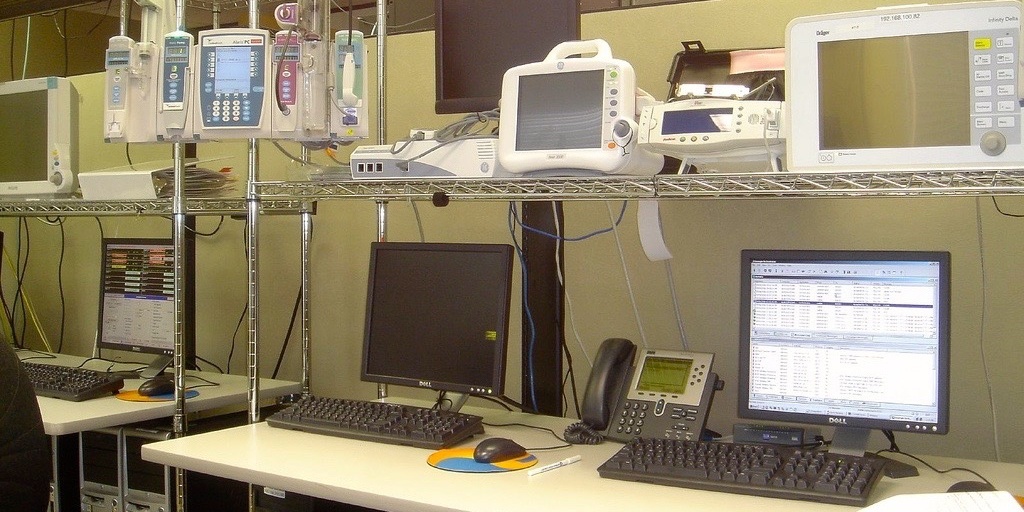Developing and launching a competitive product, and getting initial traction in the market are not inconsiderable milestones. And yet for the entrepreneur and their investors, this is just the beginning. What was record setting last quarter is barely acceptable this quarter, and next quarter had better be back on track.
Developing a solid plan for growth depends on two things: a good understanding of the basic means to drive growth, and a deep understanding of the market. This post seeks to combine both of these in a brief survey of the key factors to drive messaging middleware revenue growth in health care. We're going to consider three basic growth strategies: organic growth, product line extension, and the roll-up strategy.
Organic Growth
For start ups, organic growth can be realized first by targeting a market segment that has broad appeal and large numbers of early and late adopters. Going back to Moore's market adoption model, it's relatively easy to identify a market need and generate initial sales to innovators and early adopters. These early buyers want technology and performance, something new the buyer can leverage to gain a competitive advantage of their own.
These early buyers tend to be large institutions with a corporate culture of innovation and the internal resources to support such endeavors. Accounts like the Cleveland Clinic, Mayo Clinic, Partners Healthcare, come immediately to mind. Kaiser Permamente would also fall into this group, except they are held back by their need to have solutions that can scale to considerable extremes, a requirement that is not applied to these other health care provider titans. There is even a cadre of smaller nimble early buyers: Overlake Hospital, Bellevue, Washington, and El Camino in Mountain View spring to mind. Spend enough time in this industry and the early buyers tend to make themselves known. The problem is that this population of early buyers is quite limited; early buyers will only take a company so far.
Once most of these early buyers in a market segment have bought, the market adoption chasm arises because the next group of buyers to adopt - the much larger early majority - don't want technology and performance, they want complete, proven, easy to adopt solutions. This shift gives rise to the conventional wisdom that, "hospitals want solutions to problems, not tools they can use to solve their own problems." For vendors, the importance of this is self evident when considering how to maintain or even increase their growth rate over time. For providers, it's important to recognize from which side of the chasm your organization is operating and proceeding accordingly.
To cross the chasm, vendors must add to the original innovative technology the required features and services to create a whole product solution that is laser focused on a recognizable problem. Figuring out exactly what it is that's required to transform an innovation worthy of inspiring early buyers into the safe and reliable solution required by the early majority is a challenge. Recognizing the gaps and knowing how best to fill them is not easy, although there are processes that can be used to identify those requirements and confirm that they're met.
Moore calls the process of creating and going to market with the whole product solution being in the bowling alley. The bowling alley let's you shift your growth from the early market, which may be nearing penetration, to the much larger early majority portion of the market. Crossing the chasm is an essential objective for new companies. In a crowded market like messaging middleware, numerous companies will be struggling with crossing the chasm.
Achieving strong organic growth is an excellent indicator that, beyond a solid whole product solution, sales and market are also top notch. Sales and marketing are especially important because health care is not a field of dreams market, where "if you build it, they will come." Brand awareness, demand generation and market education are key marketing tasks. Sales requires effective sales tools and proofs in support of a sales strategy or process that leads first time buyers to the right decision in an efficient and reliable manner.
Product Line Extension
A main characteristic of the messaging middleware market is the variety of different problems that can be solved by the same basic technology. These different problems are reflected as market segments. Each of the different market segments listed in the previous blog post can potentially support a start up, or represents a potential product line extension. Moore frames these other market segments as additional bowling alleys that leverage the same foundation of product and services that make up the original whole product solution. Some product line extensions may require changes to the whole product solution to gain early majority market adoption.
Much like selecting the initial target market for a start up, the key is to identify new bowling alleys with sufficient market demand (of course, competition is also a factor). Synergy with preexisting whole product solutions is also desired. It's also helpful if the new bowling alleys under consideration target the same markets (e.g., physician practices or hospitals) so that existing sales and marketing resources can be easily leveraged to take advantage of cross-sell and up-sell opportunities that emerge. If different bowling alleys target different markets - say, physician practices for one and hospitals for another - each target market will require major investments in marketing and sales; potential synergy from a targeting a common market are lost.
Sometimes a product line extension includes product changes that add substantive new features to the platform. For example, a secure messaging solution that is designed to support a single enterprise might add the capability to support users across multiple enterprises, or the addition of a scheduling module to support a more complete secure messaging solution for on-call physicians.
Roll-up Strategy
A roll-up strategy entails a series of acquisitions used to construct a bigger company made up of complementary products or solutions. A relevant example of this strategy can be found in Amcom Software. After their merger with Xtend Communications, Amcom came to dominate the hospital operator console market (due to their HL7 integration capability) and related telephony applications. Subsequent acquisitions extended Amcom's reach with various communications solutions for health care, government and other vertical markets.
- 2007, Xtend Communications operator console, PBX, paging gateway and related telephony solutions
- 2008, Telident 911 Solutions mass notification and emergency management solution
- 2008, Comtech Wireless hospital messaging middleware solution
- 2009, SDC Solutions operator console and call center technologies
- 2012, IMCO Technologies critical test results management
Amcom Software was acquired by USA Mobility in 2011 for $176,800,000. The combined company is now called Spok (pronounced spoke with a long "o"). Starting with the merger with Xtend, the Amcom Software strategy was to build a company through acquisitions and then sell the company. With a 2010 revenue of $60 million, things appear to have worked out well for Amcom's investors.
Because of the nature of this market, a roll-up strategy can be challenging. Unlike the product line extension strategy, where a company's existing technology is reconfigured or enhanced to target new market segments, the roll-up strategy entails the acquisition of other companies. How those acquired products, employees and customers are optimized is the challenge.
Mergers and acquisitions occur frequently in the health care industry. The goals of these transactions include:
- Capturing the target company's revenue or cash flow
- Capturing the target company's installed base or market share
- Gaining access to the company's technology
- Acquiring the company's patents
- Capturing the human resources employed by the target company
- Eliminating a competitor
The first two bullets are obviously related, however the degree and ways they're related depends on the specific companies and their business models. A company that goes to market selling mostly capital goods (hardware and licensed software) is quite different from a company selling their solution as a cloud based service.
As discussed in a previous post, most messaging middleware solutions are built using a similar architecture that is often made up of software engines. These engines can be licensed from commercial vendors or from open source projects. The resulting solutions can be built relatively quickly and for modest sums. Consequently, the value in purchasing a messaging middleware vendor for their technology may be limited.
Creating interfaces between multiple messaging middleware acquisitions can be problematic. To date, messaging middleware systems have been designed to operate alone; manufacturers do not intend for their messaging middleware system to be one of a constellation of messaging solutions serving the same user base. Some manufacturers have added to existing designs by implementing APIs and other integration points to facilitate the incorporation of other messaging middleware apps - often to fill feature gaps demanded by prospective buyers. Implementing multiple messaging middleware solutions via acquisitions raises questions about message routing, escalation and the existence of more than one rules engine impacting message flow. A system of systems made up of messaging middleware solutions gets very complicated very quickly, increasing configuration and verification and validation test complexity.
An acquiring company with older software technology may see value in the acquired software platform, or in the intellectual property and expertise behind the development of that software. Further, the acquired company may have software capabilities that are extensions to messaging middleware solutions - such as the staff scheduling for on-call physician messaging example used earlier.
The acquisition of mVisum by Vocera is worth a closer look. It should be noted that Vocera does not appear to be executing a classic roll-up strategy but the rationale that may have driven this acquisition is of interest. mVisum was a start up with an attractive messaging middleware product. Unlike many other messaging middleware solutions, mVisum was FDA cleared for alarm notification, conveyed snippets of medical device waveforms with medical device alarms (important for screening non-actionable false/positive alarms), and also included remote medical device surveillance features. The company subsequently ran into some patent infringement issues with AirStrip Technologies. mVisum was acquired by Vocera for $3.5 million less than a year later.
There is considerable overlap between Vocera and mVisum solutions. Potential areas of value for Vocera include mVisum's FDA clearance for alarm notification, one of the strongest messaging middleware market segments. mVisum also filed a number of patent applications that may be of value to Vocera. Vocera was founded in 2000, so there may be some value in mVisum's software architecture - if not the actual software, then the requirements and design may be leveraged in future versions of Vocera's software.
To summarize the roll-up strategy applied to messaging middleware, there is likely not a lot of value in acquiring other messaging middleware companies when compared to the product line extension strategy. The main reason is because most software architectures will be similar. There are exceptions to this, some of which are alluded to in the Vocera/mVisum discussion above. Because the messaging middleware market is relatively undeveloped - we're far short of a penetrated market - there's little opportunity to buy cash flow or market share through acquisitions. Nor is the market so developed that human resources are a likely justification for acquisition.
The roll-up strategy does make more sense when one looks beyond messaging middleware. Just as Amcom Software took a broader view of vertical market messaging and communications solutions that included messaging middleware as a portion of the whole, one could frame a roll-up strategy from a similar, higher level. For example, a roll-up targeting health care could encompass point of care solutions, rolling-up messaging middleware with nurse call, medical device data systems (MDDS), data aggregation and patient flow with enabling technologies like real time location systems (RTLS) and unified communications (enterprise phone systems). The resulting entity could define a new enterprise software category: point of care workflow automation.
Another practical application of the roll-up strategy is the secure messaging market targeting physicians. There is little apparent differentiation between solutions and vendors with good adoption in a particular geographic market will be difficult to dislodge. Here a classic roll-up, where the acquiring company offers broader economies of scale superior to those of regional players has a lot of potential. Such a strategy would be complex to implement, due to the technical product integration issues noted above. Provided they could dedicate sufficient cash flow, this could be an attractive strategy for Spok, although any company with access to several tens of millions could pull this off.
With 100+ competitors, the messaging middleware market is remarkably crowded. Over time, many of these firms will fade away as they fail to gain initial market traction, cross the chasm or get acquired. There will certainly be mergers and acquisitions. There will be some who plan and execute well, and grow their companies to tens and hundreds of millions in annual revenue. Some degree of luck with be a factor. But regardless of the strategy or outcome, the imperative shared by them all will be the drive for growth.




Tim, good article. I am very interested in your opinion of where the EMR vendors fit in with Messaging Middleware and how that might effect growth strategies. Mobile Heartbeat is one the deep messaging companies mentioned in your previous blog about Market Segmentation. We are partnered with one of the healthcare provider titans and early adopters you did not mention, HCA, that is deploying a mobile/messaging strategy based on Mobile Heartbeat’s platform. Thanks, JB
Jamie, EMR vendors will be players in messaging — Cerner already is a player with CareAware Connect. Like with many market segments, EMR vendors will play the spoiler when they can, telling customers not to buy a messaging solution because they’re already working on one. Alternatively, they may take the position that they already have a messaging solution. My survey of HIMSS last year found that with the exception of Cerner, none of the major EMR vendors have anything close to a competitive messaging solution for the point of care. How much EMR vendors come to actually dominate messaging and how long it takes the market to mature are two key questions.
This sounds like a great subject of a separate blog post.